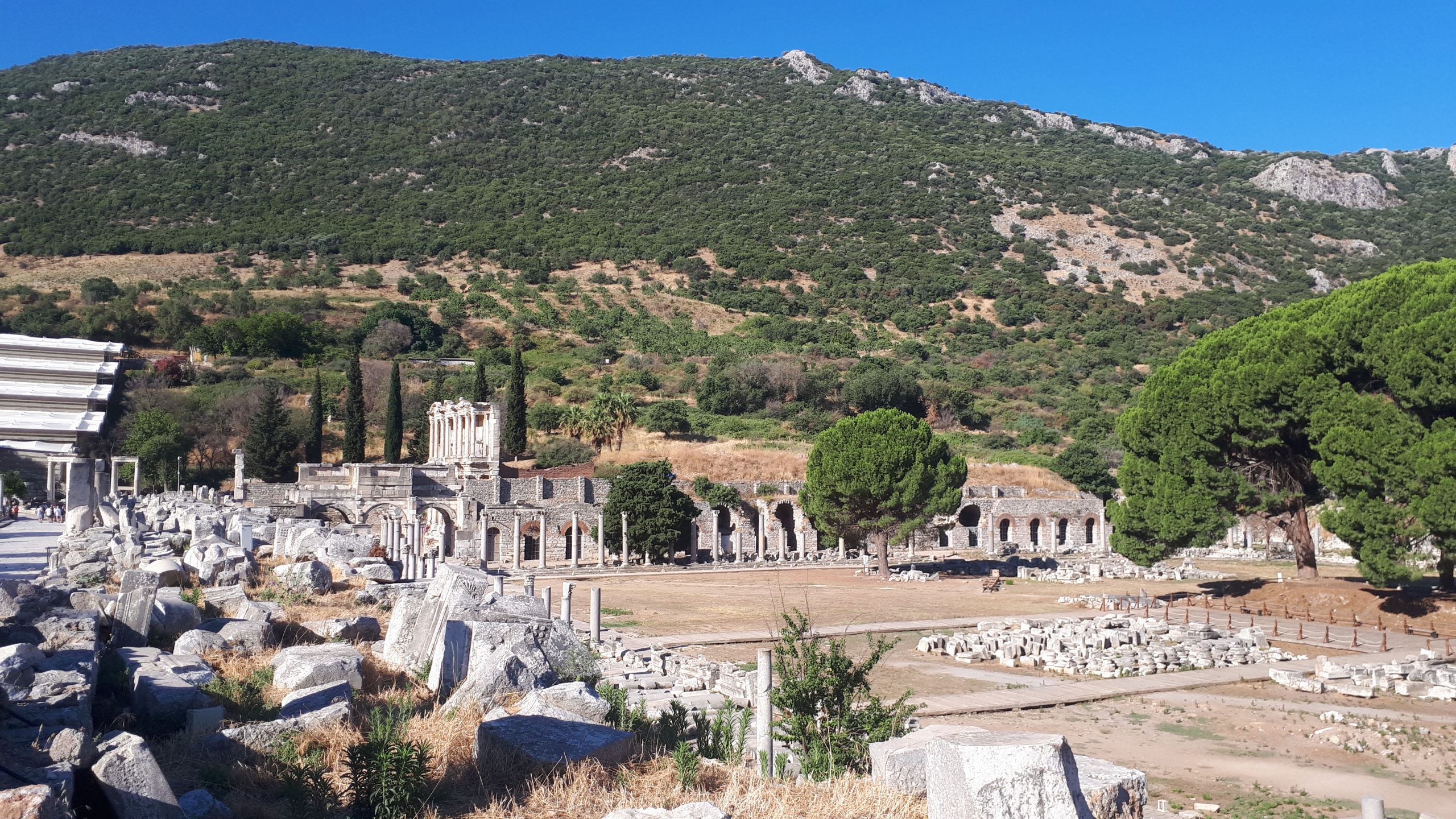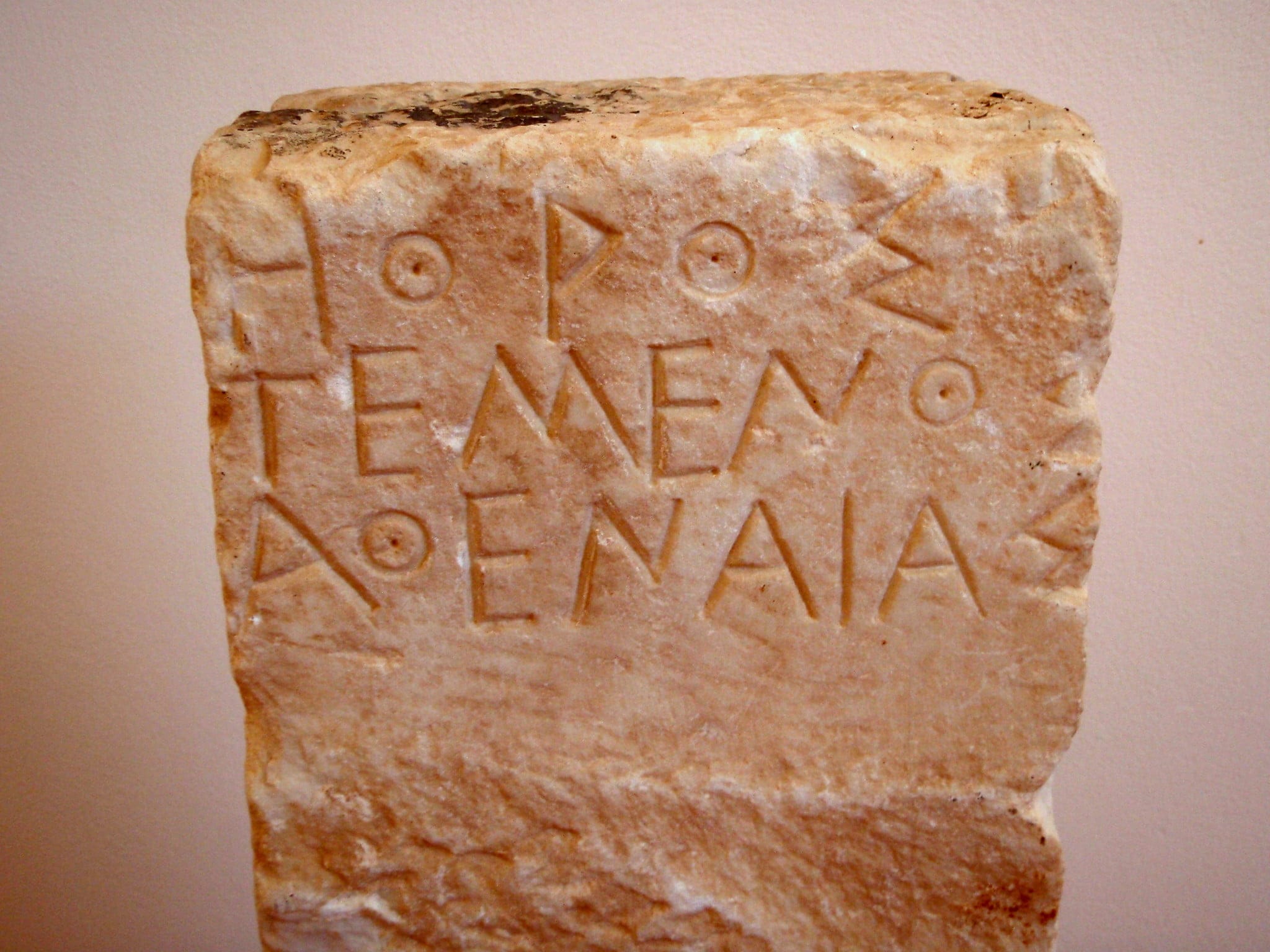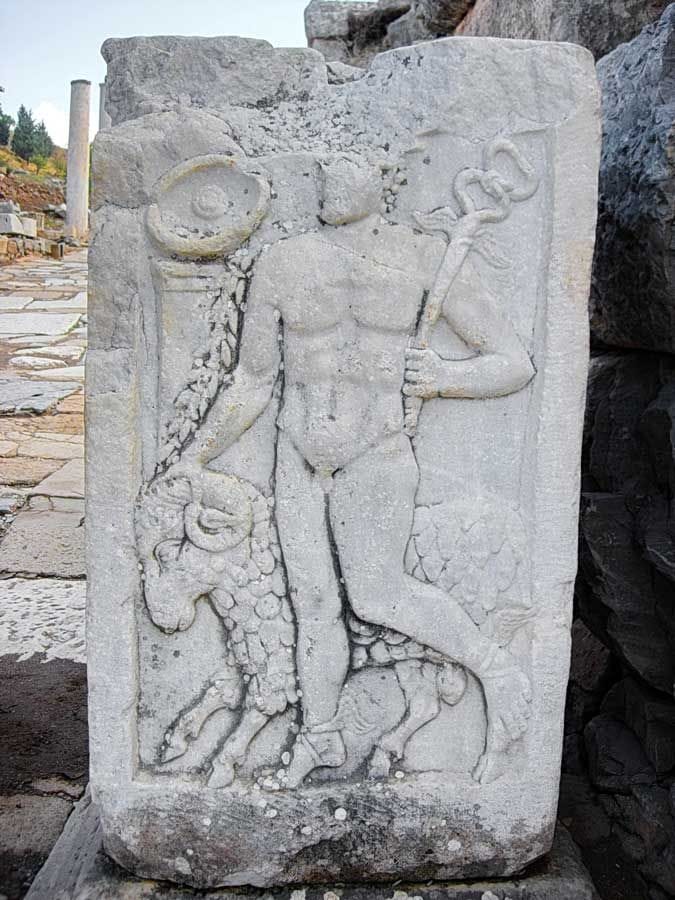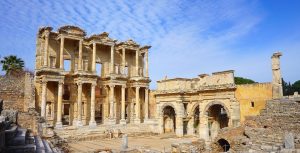Ephesus, BC; 6th century AD Until the 6th century, it served as the center of trade in Anatolia. It had outstripped its biggest rivals in both sea and land trade. B.C. When Civitas Libera, a free city title from the Roman Empire, became a free city in 29 B.C., it became a very strong economic model for the economies of Anatolia and the Ionian Union by making its own laws and printing its own money.
The city of Ephesus, which minted its own coins in the Hellenic period before the Roman Empire, became a superpower city both commercially and economically in the following period.
Ephesus Economy Topics
Until a certain time after the establishment of Ephesus, shopping was based on the exchange system, not barter. The values in this exchange were either an ox, a woman, a piece of armor, or a piece of copper or bronze metal. A single stick used in barter from the Hellenic world was called an “obol.” A handful of sticks were called Drachmas.
These two terms appeared as the main units of the Attic monetary system after the invention of money. In Anatolia, the currency value was “starter,” which means unchanged.
Money was used for the first time in the world in B.C.It was invented in Ionia in the early 7th century. The first coin with symbolic motifs on it, minted by the Lydian state during the time of Alyattes I, dates back to BC. It was printed in 640 pixels. The first minted coins were made from an alloy called Electron, which consisted of a mixture of 60% gold and 40% silver.
These first coins had some rectangular cavities (Quadratum Incusum) on their obverses. Their backs were completely flat. From the 7th century BC, during the archaic period, which lasted until the middle of the 5th century, the Hellenic city-states minted mostly silver coins with small amounts of gold and electron coins. In the city-states of Anatolia and also in Ephesus, mostly silver and gold coins were minted, with a small amount of gold.
The exchange rates for the noble metals used in coin minting were 1/10, 13, and 1/10, respectively.
On the obverse of the coins minted in the Archaic period in Ephesus, the motifs related to the founding legend of the city or the emblems symbolizing the city, the goddess Artemis, or the animal bee and deer, which are considered sacred by the people of the city, as well as plant motifs, are seen. On the reverse sides are the rectangular cavities seen on the first coins.

To give an example of these archaic coins, the bee or deer motif on the coins of Ephesus, the lion on the coins of Miletus, the owl on the coins of Athens, the turtle on the coins of Aigina, and the pomegranate motif on the coins of Side can be shown as the best examples.
BC in the classical period in Ephesus. Silver coins, rather than emerald or gold coins, were minted in the fifth and fourth centuries. The goddess Artemis, taken from Hellenic mythology, is depicted on the obverse of the coins of this period, and the bee and deer motifs seen in the Archaic period are depicted as reliefs on the reverse.
BC in Ephesus during the Hellenistic period. In the 3rd and 1st centuries, gold and bronze coins were minted, as well as silver coins. On the obverse of the coins of the Hellenistic period, the portraits of the prominent figures of the period and the city of Ephesus are depicted, and on the reverse, the goddess Artemis and mythological motifs seen on the obverse in the Classical period are depicted as reliefs.
Coins have been minted within certain systems since the time they were first minted. The main coin systems used in Ephesus are:
The Atikka coin system emerged in the middle of the 6th century B.C.This coin system was immediately adopted by the city-states, especially under the influence of Athens, and continued its effectiveness in all Hellenic, Ephesus, and Ionian cities, as well as in Anatolia, until the Roman period.
Hellenic Coins in Ephesus
1 Talent = 26,196 kg
1 Mina = 436,6 gr
1 Decadrachm = 43,6 gr
1 Tetradrachm = 17,6 gr
1 Didrachm = 8,73 gr
1 Drachm = 4,36 gr
1 Tetrobol =2,91 gr
1 Triobol = 2,18 gr
1 Diobol = 1,45 gr
1 Obol = 0,73 gr
1 Tritartemorion = 0,55 gr
1 Tetartemorion = 0,18 gr
The most common currency used in Ephesus was the drachm, and smaller currencies than the drachm were also used.
After the Hellenic system, Alexander the Great and his generals used the Macedonian system in the Ephesus city economy. The generals are still alive when these coins are used.
In this system, the main currency is the drachm, whose weight is 4.3 gr, and the weight of the tetradrachm is 16.1 gr.
Apart from these systems, the Lydian system, the Miletos system, and the Phoenician system were also used in the economy of Ephesus, albeit a little. However, these coins did not attract much attention.
Prices, fees, and purchasing in Ephesus
B.C. As a result of the colonization movements that started in 1200 and lasted until the 7th century BC, city-states (polis) were formed both in Helena, Italy, and Anatolia. These states consisted of a single city. Like the city of Ephesus, the people of the city cultivated the lands around the city, operated the mines close to the city, raised animals, and made their living by trade.
The city of Ephesus governed itself with the rulers they elected, their own laws, and their own coins. In short, we can say that the city of Ephesus is an autonomous city. The meaning of the word comes from the Greek meaning of “self” (auto) and “rule-making (nomos).
However, BC. In the period from the middle of the 6th century until the end of the Hellenistic period, the autonomy of the city administration of Ephesus was limited from time to time, both during the Persian domination, the effectiveness of the Attica Delos Marine Union established in 478/477 BC, and the rule of Alexander the Great and his commanders (the Diadochi).
The city of Ephesus paid taxes to the sovereign powers. When the domination of the sovereign powers came to an end, the city of Ephesus regained its economic freedom. The event continued in this way until the Roman period. In the Roman period, the city of Ephesus was connected to the Asian province of Rome.
The economy of the city of Ephesus was indirectly dependent on the decisions of the Roman emperors and the Roman senate.

During the Hellenistic period, the city of Ephesus could be economically divided into three groups.
1. Employees: For example, doctors, teachers, soldiers, architects, sculptors, and musicians
2. Self-employed: These include landowners, artisans, sellers, farmers, and animal owners.
3- Slaves
In the early days, grain production and livestock were the basis of economic life in Ephesus. Ceramics, weaving, and maritime transport were influential in later periods. Those who work and those who produce have always been glorified by philosophers, and those who earn without working have been looked down upon.
Those who were unemployed from time to time in the agricultural sector and could not earn enough money for their living were called Thetes. Those who were handicraftsmen or artisans but could not earn enough money were called Banausoi, who were generally poor people who were unable to do their jobs due to disability or work accidents.
The wealthy employed the Thetes on their ships, on their farms, or as mercenaries. When the state coffers were not empty, it was dignified to be a mercenary. Soldiers were well paid. In addition to their fixed salaries, the soldiers also provided themselves with additional income by looting the cities or settlements they captured.

The wages of the wage earners were covered by the coffers of the Ephesus city administration or by the employers. When there was a gap between the income levels of the poor people and the rich people in Ephesus from time to time, the rulers of the city of Ephesus found this situation economically and politically inconvenient for Ephesus, and they occasionally sought to provide jobs to the unemployed and the poor.
The most valid way of doing this was to build a temple or a sanctuary in Ephesus and employ the unemployed in those areas.
B.C. The wages of freelancers in the city of Ephesus, which began to develop and grow in the 5th century, were 2 obols. The daily wage of a regular soldier who participated in any war in Ephesus was 3 obols. The daily wage of the ship’s workers and the mud carrier, who was an unskilled worker, was 3 obols.
A daily wage of 1 drachm was paid to the hand workers and their assistants working in the construction of the Temple of Artemis in Ephesus.
The wage paid during the war for the equipped foot soldiers (Hoplite) in Ephesus was 2 drachmas per day.
In the 4th century B.C., unskilled workers were paid 1.5 drachmas per day, master workers were paid 2 drachmas per day, and architects were paid 2.5 drachmas per day in the temple of Artemis in Ephesus and the sanctuary. In the city of Ephesus, this fee was paid to the Ephesian architects for the whole year, while other employees were paid for the time they worked.
The wage of a worker who produced 100 ceramics a day in the 4th century BC in the city of Ephesus was 1 drachm. In the same period, he was paid 20 drachms for 1000 letters engraved by a slave on an inscription and 1 obol for a slave working in a mine.
Historians in Ephesus, BC In the 5th century, the annual base wage was approximately 120–130 drachms (BC). In the 4th century, they stated that this figure was 180 drachms.
These fees were valid not only for the city of Ephesus but also for the cities of the Ionian Union, all Anatolian and Hellenic cities.
In order to get to know the economic life in the city of Ephesus better, you can see the prices of some products from the 5th century BC and the 4th century BC.
Product unit prices in Ephesus
| Wheat | B.C. 450 – 400 | 1 Medimnos (unit of measure for grain) | 6-6,5 Drachm |
| Wheat | B.C. 350 – 300 | 1 Medimnos (unit of measure for grain) | 9 Drachm |
| Wine | B.C. 450 – 400 | 1 Metretes (unit of measure for liquid) | 0,6 – 10,5 Drachm |
| Wine | B.C. 350 – 300 | 1 Metretes (unit of measure for liquid) | 4 Drachm |
| Barley | B.C. 350 – 300 | 1 Medimnos (unit of measure for grain) | 6 Drachm |
| Olive | B.C. 400 – 350 | 1 Chonix (unit of measure for olives) | 1/3 Obol |
| Olive Oil | B.C. 400 – 350 | 1 Metretes (unit of measure for liquid) | 12 Drachm |
| Dry fig | B.C. 400 – 350 | 1 Medimnos (unit of measure for grain) | 2 Drachm |
| 1 Himation | B.C. 400 – 350 | 20 Drachm | |
| 1 Pair of Shoes | B.C. 400 – 350 | 8 Drachm | |
| 1 Bed (Cline) | B.C. 450 – 400 | 5 Drachm | |
| 1 Table (Trapeza) | B.C. 450 – 400 | 4 Drachm | |
| 1 Stool | B.C. 450 – 400 | 1 Drachm | |
| 1 Chair (Diphros) | B.C. 450 – 400 | 2 Drachm | |
| All house Furniture | B.C. 400 – 350 | 1000 Drachm | |
| 1 Ox | B.C. 450 – 400 | 51 Drachm | |
| 1 Ox | B.C. 400 – 350 | 70 Drachm | |
| 1 Goat | B.C. 400 – 350 | 10 Drachm | |
| 1 Sheep | B.C. 400 – 350 | 15 – 12 Drachm | |
| 1 Horse | B.C. 450 – 400 | 1200 Drachm | |
| 1 Piglet | B.C. 450 – 400 | 3 Drachm | |
| 1 Acre of land in the interior | B.C. 450 – 400 | 6000 Drachm | |
| 1 Acre of land on the coast | B.C. 450 – 400 | 15.000 Drachm | |
| 1 House | B.C. 450 – 400 | 105 – 1900 Drachm | |
| 1 House | B.C. 400 – 400 | 3000 Drachm | |
| 1 Ax (Labrys) | B.C. 450 – 400 | 2 Drachm | |
| 1 Oil container (Lekythos) | B.C. 450 – 400 | 1 Obol | |
| 1 Slave | B.C. 450 – 400 | 60 – 360 Drachm | |
| 1 Slave | B.C. 400 – 350 | 200 Drachm |
Money Trading in Ephesus
Temple of Artemis – The First Banking System in the World and One of the Seven Wonders of the World
First, the money trade was made by the rulers of the temples in the sanctuaries. The best example of this is the Temple of Artemis in Ephesus. In ancient times, the temple of Artemis had income from the gifts given to it as war booty, the leasing of the lands belonging to the sanctuary, and the accumulation of fines given to individuals by the Ephesus city council.
The priests of the Temple of Artemis gave money with interest to those who demanded it from their earnings and savings, and they used the money brought to the temple as a bank to keep it safe.
The lending (credit) process required a certain formality. The loan was given in the presence of witnesses to those who made the request, and the person or persons who wanted to withdraw the loan were asked for a guarantee that they would pay it back. A debt contract was prepared, in which the debtor mortgaged his land as collateral.

Usually, double the amount of the loan was required. If the borrower had no land, he could show his family or himself as a pledge. There have been many people who could not pay their debts and lost their freedom or were sold into slavery. If the debtor mortgaged his land, a stone was placed at the head of his land, indicating that the land was mortgaged, and it was called the mortgage stone.
After the Temple of Artemis in Ephesus, the Temple of Apollo in Delphi in Greece is seen as a credit facility. The temple of Artemis, which lends money to people, was built in BC. The 400s also received 10% interest on the money they gave. This interest rate is It lasted until the second century.
In the temple of Artemis in Ephesus, lending began in the 4th century BC. In the temple of Artemis in Ephesus, they applied 12% annual interest to the agricultural sector and 16–18% of the loans they gave to the merchants.
In Ephesus, it is seen that in the 4th century BC, private individuals traded money, and it is known that these people made great fortunes. These people applied high-interest rates to those who traded with ships.
For ships engaged in maritime trade, they determined the interest rate according to the condition of the route they sailed. For these ships, they used a 20–33% interest rate for the round trip, and they gave this loan only for the summer months.
The interest on the loans given to the agricultural sector and traders in Ephesus was generally 12% and was collected monthly from the debtor at the end of each month. Many agreements on borrowing set the deadline for payment of the debt at the end of the next month.
Taxes in Ephesus
In Ephesus, in the first periods of taxation, landowners and the rich met the necessary expenses for the city-state administration, financed the holidays, supplied the necessary weapons and equipment for the war before the war (Eisphora = war tax), paid tribute (tax + tribute) to another state, and paid the dues to the union. They collected money among themselves in proportion to their economic power and gave it to the people’s assembly.

There were no regular taxes, such as income tax or property tax, paid each year. Apart from the money collected in the form of personal aid, there were fixed incomes belonging to the state. such as renting state lands for certain periods (for 30 to 40 years) or selling the right to citizenship.
A member of the Ephesus city council was given the job of collecting money from people with a certain income level; this person was collecting this money, and he was given a 2% share of the money he collected in return for the work he did.
As the commercial life of the city of Ephesus expanded, some taxes were imposed to tax the commercial gains. For example, the import and export tax (Pentecost) from an inscription in Ephesus, such as the 2% import and export tax, is in British Columbia. It was clearly placed in the sixth century.
The inscription also mentions salt, timber, ships, and taxes. However, these taxes were abolished from time to time for businessmen.
The economy in Ephesus, Roman Period
The money in the early Roman period, Aes grave (heavy coin), was also used in the commercial system of Ephesus. During the Roman period, there was always an inscription on the obverse of the coins describing the definition of the emperor or empress as abbreviations, and on the reverse side, there were descriptions of the emperor’s achievements together with mythological characters.
Roman-period coins used in trade in Ephesus
| 300 – 250 BC | 250 – 220 BC | 220 – 190 BC | |
| 1 As | 321 gr | 267 gr | 32 gr |
| 1 Semis | 160 gr | 134 gr | 73 gr |
| 1 Triens | 106 gr | 85 gr | 53 gr |
| 1 Quadrans | 80 gr | 66 gr | 36 gr |
| 1 Sextans | 55 gr | 44 gr | |
| 1 Uncia | 27 gr | 22 gr | |
| 1 Semiuncia | 17 gr | 13 gr |
Coins from the Roman imperial period used in Ephesus
Gold coins used in Ephesus
| Avreus (25 Denarius) | 8,18 – 4,67 gr | Between 0 – 350 AD |
| Solidus | 4,54 gr | Between 300 – 480 AD |
| Tremissis | 1,51 gr | Between 390 – 480 AD |
| Scripilum | 1,70 gr | Between 310 – 480 AD |
Silver coins used in the Roman period in Ephesus
| Denarius (= 16 As) | 3,89 gr – 2,37 gr | Between 0 – 270 AD |
| Quinarius | 1,85 gr – 1,26 gr | Between 0 – 300 AD |
| Antoninianus | 4,86 gr – 3,22 gr | Between 200 – 350 AD |
| Argenteus | 3,41 gr – 2,37 gr | Between 300 – 400 AD |
| Siliqua | 2,3 gr | Between 370 – 480 AD |
| Heavy Milliarense | 5,54 gr | Between 330 – 480 AD |
| Light Miliarense | 4,54 gr | Between 330 – 480 AD |
| Cistophor | 12 gr | Between 0 – 220 AD |
Bronze coins used in Ephesus during the Roman period
| Sesterz = (4 As) | 18 gr – 29 gr | Between 0 – 280 AD |
| Dupondius | 10 gr – 14 gr | Between 0 – 280 AD |
Copper coins used in Ephesus during the Roman period
| As | 8 gr – 12 gr | Between 0 – 280 AD |
| Follis | 10gr – 15 gr | Between 280 – 345 AD |
| Maiorina | 10 gr – 15 gr | Between 330 – 480 AD |
| Centonionalis | 10 gr – 15 gr | Between 330 – 480 AD |
The Roman coins used in Ephesus were minted by the Roman Senate; silver and gold coins were minted by the emperor during the imperial period. The motifs on the bronze coins are the same as on the silver coins; only the letters S.C. (Senatus Consultum).
In the Roman period, professional departments and trade in Ephesus were just like in the Hellenic period. However, during the Roman period, trade in Ephesus was carried out more extensively. Branches such as weaving, ceramics, and mining have become industries in Ephesus.
In the state of Ionia, gold and silver works were highly appreciated and in high demand. The cities of Ephesus and Symrna were very famous in this regard.
Prices and wages were given in Ephesus during the Roman Period
| The daily wage of the weaver of coarse cloth | 12 Denarius |
| The daily wage of a woman weaving fine fabric | 16 Denarius |
| Daily wages of shepherds and simple workers | 20 Denarius |
| Daily wages of Farmers and silk weavers | 25 Denarius |
| The daily wages of masons, mosaic workers, chambermaids, sailors | 50 Denarius |
| Marble workers, shipbuilders’ daily wages | 60 Denarius |
| The daily wage of painters and ceramists | 75 Denarius |
| Vase painters’ daily wage | 150 Denarius |
| The daily wage of shroud fabric workers | 300 Denarius |
These fees were valid for Ephesian men. Ephesian women were paid 20% to 40% less than their wages.
Considering these prices and fees, the person who received the lowest price could increase by 2 denarii after meeting his daily needs. Furthermore, the poor in Ephesus were able to receive city administration benefits such as child benefits, a wheat grant, and free admission to the baths.
Some of the Roman Period’s daily shopping fees in Ephesus
| Wheat | 1 Modili | 50 Denarius |
| Wine | 1 Sextarius | 8 – 30 Denarius |
| Olive Oil | 1 Sextarius | 12 – 40 Denarius |
| Meat | ½ kg | 8 – 20 Denarius |
| Fish | ½ kg | 6 – 24 Denarius |
| Vegetable | 5 – 10 pieces | 4 – 6 Denarius |
| Egg | A piece | 1 Denarius |
| Shoes | 1 Pair | 60 – 150 Denarius |
| Tunic fabric | 500 Denarius |
In the 4th century AD and later, in Ephesus, people generally sold themselves as slaves and fell into a situation to fill their stomachs. Taxes collected were at the forefront of the financial resources required for the administration of the Ephesus city administration. AD In the 6th century, the city of Ephesus made some administrative arrangements and tried to find solutions by identifying some problems.
Taxes collected in Ephesus during the Roman period
Agricultural tax: In the third century AD, it is a tax that applies to all farmers who own land.
Income tax (Tributum Soli): It is collected from land and capital owners. This tax was levied in grain or its equivalent in money. This tax type has been revised every 5 years by checking the returns.
Poll tax (Tributum Capitis): It was taken from workers and slaves. This tax is determined according to the work of the person.
Inheritance tax: Inheritance of up to 100,000 Sesterz is exempt from tax. Inheritance of more than 100,000 Sesterz is subject to a 5% tax. This tax was increased to 10% after the 3rd century AD.
Tax on those who are released: 5% of their annual earnings. It increased to 10% after the 3rd century AD.
Customs duties: Taxed according to the type of imported goods. The taxes on luxury items were kept high.
Taxes collected from tenders: 1% of the value of the goods sold in the tender.
Taxes on slave sales: 4% of the slave sale value. Therefore, half of the percentage was collected from the buyer and half from the seller.
Most of the taxes collected were spent on the army. In the 1st century BC, the monthly salary (sol) paid to the soldiers was 225 denarius (900 sesterz), while this rate was increased to 300 denarius (1200 sesterz) in the 1st century AD. The city of Ephesus gained the title of “free city” in 29 BC. In this way, the city of Ephesus could make its laws and collect its taxes.





